
Mastering Custom SageMaker Deployment: A Comprehensive Guide
A deep dive into the intricacies of deploying custom models to Amazon SageMaker

Since we have already analyzed all these datasets in the target countries section, we see that using the global dataset for all our modeling is the best option for a few reasons:
our main objective is to see which one of our chosen 4 countries have handled the virus in a way that can be generalized to everyone as simple guidelines, the targeted countries are
import pandas as pd
import numpy as np
import matplotlib.pyplot as plt
import tensorflow as tf
from datetime import datetime
from sklearn.preprocessing import MinMaxScaler
from keras.preprocessing.sequence import TimeseriesGenerator
from keras.models import Sequential
from keras.layers import Dense, LSTM, Dropout, Activation, GlobalMaxPooling1D, Bidirectional
from keras.optimizers import Adam
from tensorflow.keras.callbacks import ModelCheckpoint
from statsmodels.tsa.arima_model import ARIMA
from statsmodels.tsa.api import ExponentialSmoothing, SimpleExpSmoothing, Holt
%matplotlib inline
# supress annoying warning
import warnings
from statsmodels.tools.sm_exceptions import ConvergenceWarning
warnings.simplefilter('ignore', ConvergenceWarning)
df_confirmed = pd.read_csv("../input/covid-19/time_series_covid19_confirmed_global.csv")
df_deaths = pd.read_csv("../input/covid-19/time_series_covid19_deaths_global.csv")
df_reco = pd.read_csv("../input/covid-19/time_series_covid19_recovered_global.csv")
after reading in our dataset lets take a look at it by showing the first few countries for confirmed case, deaths, and recoveries
df_confirmed.head()
| Province/State | Country/Region | Lat | Long | 1/22/20 | 1/23/20 | 1/24/20 | 1/25/20 | 1/26/20 | 1/27/20 | ... | 10/22/20 | 10/23/20 | 10/24/20 | 10/25/20 | 10/26/20 | 10/27/20 | 10/28/20 | 10/29/20 | 10/30/20 | 10/31/20 | |
|---|---|---|---|---|---|---|---|---|---|---|---|---|---|---|---|---|---|---|---|---|---|
| 0 | NaN | Afghanistan | 33.93911 | 67.709953 | 0 | 0 | 0 | 0 | 0 | 0 | ... | 40626 | 40687 | 40768 | 40833 | 40937 | 41032 | 41145 | 41268 | 41334 | 41425 |
| 1 | NaN | Albania | 41.15330 | 20.168300 | 0 | 0 | 0 | 0 | 0 | 0 | ... | 18250 | 18556 | 18858 | 19157 | 19445 | 19729 | 20040 | 20315 | 20634 | 20875 |
| 2 | NaN | Algeria | 28.03390 | 1.659600 | 0 | 0 | 0 | 0 | 0 | 0 | ... | 55357 | 55630 | 55880 | 56143 | 56419 | 56706 | 57026 | 57332 | 57651 | 57942 |
| 3 | NaN | Andorra | 42.50630 | 1.521800 | 0 | 0 | 0 | 0 | 0 | 0 | ... | 3811 | 4038 | 4038 | 4038 | 4325 | 4410 | 4517 | 4567 | 4665 | 4756 |
| 4 | NaN | Angola | -11.20270 | 17.873900 | 0 | 0 | 0 | 0 | 0 | 0 | ... | 8582 | 8829 | 9026 | 9381 | 9644 | 9871 | 10074 | 10269 | 10558 | 10805 |
5 rows × 288 columns
df_deaths.head()
| Province/State | Country/Region | Lat | Long | 1/22/20 | 1/23/20 | 1/24/20 | 1/25/20 | 1/26/20 | 1/27/20 | ... | 10/22/20 | 10/23/20 | 10/24/20 | 10/25/20 | 10/26/20 | 10/27/20 | 10/28/20 | 10/29/20 | 10/30/20 | 10/31/20 | |
|---|---|---|---|---|---|---|---|---|---|---|---|---|---|---|---|---|---|---|---|---|---|
| 0 | NaN | Afghanistan | 33.93911 | 67.709953 | 0 | 0 | 0 | 0 | 0 | 0 | ... | 1505 | 1507 | 1511 | 1514 | 1518 | 1523 | 1529 | 1532 | 1533 | 1536 |
| 1 | NaN | Albania | 41.15330 | 20.168300 | 0 | 0 | 0 | 0 | 0 | 0 | ... | 465 | 469 | 473 | 477 | 480 | 487 | 493 | 499 | 502 | 509 |
| 2 | NaN | Algeria | 28.03390 | 1.659600 | 0 | 0 | 0 | 0 | 0 | 0 | ... | 1888 | 1897 | 1907 | 1914 | 1922 | 1931 | 1941 | 1949 | 1956 | 1964 |
| 3 | NaN | Andorra | 42.50630 | 1.521800 | 0 | 0 | 0 | 0 | 0 | 0 | ... | 63 | 69 | 69 | 69 | 72 | 72 | 72 | 73 | 75 | 75 |
| 4 | NaN | Angola | -11.20270 | 17.873900 | 0 | 0 | 0 | 0 | 0 | 0 | ... | 260 | 265 | 267 | 268 | 270 | 271 | 275 | 275 | 279 | 284 |
5 rows × 288 columns
df_reco.head()
| Province/State | Country/Region | Lat | Long | 1/22/20 | 1/23/20 | 1/24/20 | 1/25/20 | 1/26/20 | 1/27/20 | ... | 10/22/20 | 10/23/20 | 10/24/20 | 10/25/20 | 10/26/20 | 10/27/20 | 10/28/20 | 10/29/20 | 10/30/20 | 10/31/20 | |
|---|---|---|---|---|---|---|---|---|---|---|---|---|---|---|---|---|---|---|---|---|---|
| 0 | NaN | Afghanistan | 33.93911 | 67.709953 | 0 | 0 | 0 | 0 | 0 | 0 | ... | 33831 | 34010 | 34023 | 34129 | 34150 | 34217 | 34237 | 34239 | 34258 | 34321 |
| 1 | NaN | Albania | 41.15330 | 20.168300 | 0 | 0 | 0 | 0 | 0 | 0 | ... | 10395 | 10466 | 10548 | 10654 | 10705 | 10808 | 10893 | 11007 | 11097 | 11189 |
| 2 | NaN | Algeria | 28.03390 | 1.659600 | 0 | 0 | 0 | 0 | 0 | 0 | ... | 38618 | 38788 | 38932 | 39095 | 39273 | 39444 | 39635 | 39635 | 40014 | 40201 |
| 3 | NaN | Andorra | 42.50630 | 1.521800 | 0 | 0 | 0 | 0 | 0 | 0 | ... | 2470 | 2729 | 2729 | 2729 | 2957 | 3029 | 3144 | 3260 | 3377 | 3475 |
| 4 | NaN | Angola | -11.20270 | 17.873900 | 0 | 0 | 0 | 0 | 0 | 0 | ... | 3305 | 3384 | 3461 | 3508 | 3530 | 3647 | 3693 | 3736 | 4107 | 4523 |
5 rows × 288 columns
after taking a look at the data as a whole lets now get our target countries each in their own dataframes
us_confirmed = df_confirmed[df_confirmed["Country/Region"] == "US"]
us_deaths = df_deaths[df_deaths["Country/Region"] == "US"]
us_reco = df_reco[df_reco["Country/Region"] == "US"]
germany_confirmed = df_confirmed[df_confirmed["Country/Region"] == "Germany"]
germany_deaths = df_deaths[df_deaths["Country/Region"] == "Germany"]
germany_reco = df_reco[df_reco["Country/Region"] == "Germany"]
italy_confirmed = df_confirmed[df_confirmed["Country/Region"] == "Italy"]
italy_deaths = df_deaths[df_deaths["Country/Region"] == "Italy"]
italy_reco = df_reco[df_reco["Country/Region"] == "Italy"]
sk_confirmed = df_confirmed[df_confirmed["Country/Region"] == "Korea, South"]
sk_deaths = df_deaths[df_deaths["Country/Region"] == "Korea, South"]
sk_reco = df_reco[df_reco["Country/Region"] == "Korea, South"]
us_reco
| Province/State | Country/Region | Lat | Long | 1/22/20 | 1/23/20 | 1/24/20 | 1/25/20 | 1/26/20 | 1/27/20 | ... | 10/22/20 | 10/23/20 | 10/24/20 | 10/25/20 | 10/26/20 | 10/27/20 | 10/28/20 | 10/29/20 | 10/30/20 | 10/31/20 | |
|---|---|---|---|---|---|---|---|---|---|---|---|---|---|---|---|---|---|---|---|---|---|
| 231 | NaN | US | 40.0 | -100.0 | 0 | 0 | 0 | 0 | 0 | 0 | ... | 3353056 | 3375427 | 3406656 | 3422878 | 3460455 | 3487666 | 3518140 | 3554336 | 3578452 | 3612478 |
1 rows × 288 columns
with the current data structure shown above we cant do much so lets first convert it to a form that can used to make graphs or train a model
## structuring timeseries data
def confirmed_timeseries(df):
df_series = pd.DataFrame(df[df.columns[4:]].sum(),columns=["confirmed"])
df_series.index = pd.to_datetime(df_series.index,format = '%m/%d/%y')
return df_series
def deaths_timeseries(df):
df_series = pd.DataFrame(df[df.columns[4:]].sum(),columns=["deaths"])
df_series.index = pd.to_datetime(df_series.index,format = '%m/%d/%y')
return df_series
def reco_timeseries(df):
# no index to timeseries conversion needed (all is joined later)
df_series = pd.DataFrame(df[df.columns[4:]].sum(),columns=["recovered"])
return df_series
us_con_series = confirmed_timeseries(us_confirmed)
us_dea_series = deaths_timeseries(us_deaths)
us_reco_series = reco_timeseries(us_reco)
germany_con_series = confirmed_timeseries(germany_confirmed)
germany_dea_series = deaths_timeseries(germany_deaths)
germany_reco_series = reco_timeseries(germany_reco)
italy_con_series = confirmed_timeseries(italy_confirmed)
italy_dea_series = deaths_timeseries(italy_deaths)
italy_reco_series = reco_timeseries(italy_reco)
sk_con_series = confirmed_timeseries(sk_confirmed)
sk_dea_series = deaths_timeseries(sk_deaths)
sk_reco_series = reco_timeseries(sk_reco)
# join all data frames for each county (makes it easier to graph and compare)
us_df = us_con_series.join(us_dea_series, how = "inner")
us_df = us_df.join(us_reco_series, how = "inner")
germany_df = germany_con_series.join(germany_dea_series, how = "inner")
germany_df = germany_df.join(germany_reco_series, how = "inner")
italy_df = italy_con_series.join(italy_dea_series, how = "inner")
italy_df = italy_df.join(italy_reco_series, how = "inner")
sk_df = sk_con_series.join(sk_dea_series, how = "inner")
sk_df = sk_df.join(sk_reco_series, how = "inner")
us_df
| confirmed | deaths | recovered | |
|---|---|---|---|
| 2020-01-22 | 1 | 0 | 0 |
| 2020-01-23 | 1 | 0 | 0 |
| 2020-01-24 | 2 | 0 | 0 |
| 2020-01-25 | 2 | 0 | 0 |
| 2020-01-26 | 5 | 0 | 0 |
| ... | ... | ... | ... |
| 2020-10-27 | 8778055 | 226696 | 3487666 |
| 2020-10-28 | 8856413 | 227685 | 3518140 |
| 2020-10-29 | 8944934 | 228656 | 3554336 |
| 2020-10-30 | 9044255 | 229686 | 3578452 |
| 2020-10-31 | 9125482 | 230548 | 3612478 |
284 rows × 3 columns
data visualization and descriptive analysis for each country
us_df.plot(figsize=(14,7),title="United States confirmed, deaths and recoverd cases")
<matplotlib.axes._subplots.AxesSubplot at 0x7f541b66df50>
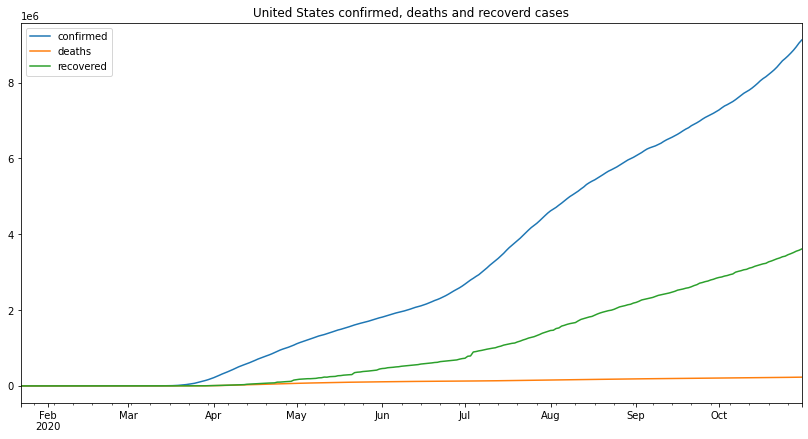
the number of confirmed cases started up slow until around April, it started to go up at a much faster rate and it kept that pace even during quarantine, in July the rate at which the cases are increasing got higher and the cases started increasing faster, this can be attributed to the recent protests and people’s ignorance to the CDC guidelines.
deaths are the only cases that have had a continuously increasing rate, all the way from April the number of deaths is increasing at an increasing rate, until august where the increase rate is slower despite the higher number of cases.
when it comes to the recoveries, the recovery starts at the same time as the confirmed cases with a very unstable increase rate, the highest increase rate is also from around July which is surprising considering the rate of confirmed cases also went up around that time.
us_cases_outcome = (us_df.tail(1)['deaths'] + us_df.tail(1)['recovered'])[0]
us_outcome_perc = (us_cases_outcome / us_df.tail(1)['confirmed'] * 100)[0]
us_death_perc = (us_df.tail(1)['deaths'] / us_cases_outcome * 100)[0]
us_reco_perc = (us_df.tail(1)['recovered'] / us_cases_outcome * 100)[0]
us_active = (us_df.tail(1)['confirmed'] - us_cases_outcome)[0]
print(f"Number of cases which had an outcome: {us_cases_outcome}")
print(f"percentage of cases that had an outcome: {round(us_outcome_perc, 2)}%")
print(f"Deaths rate: {round(us_death_perc, 2)}%")
print(f"Recovery rate: {round(us_reco_perc, 2)}%")
print(f"Currently Active cases: {us_active}")
Number of cases which had an outcome: 3843026
percentage of cases that had an outcome: 42.11%
Deaths rate: 6.0%
Recovery rate: 94.0%
Currently Active cases: 5282456
the percentage of cases that had an outcome is just 38.06% of the total cases, which is very low, the other 61.4 of the cases which are not accounted for have probably not been released officially by the government, however, the recovery rate is high at 91.79% while the death rate is at 8.21%
number of currently active cases is still very high, and it’s going up if the current increase rates are to be quoted.
for modeling and predicting the number of cases in the upcoming days the following types of models will be implemented:
LSTMs’ are known and widely used in time sensitive data where a variable is increaing with time depending on the values from prior days.
models the next step in the sequence as a linear function of the observations and resiudal errors at prior time steps.
also referred to as holt’s linear trend model or double exponential smoothing, models the next time step as an exponentially weighted linear function of observations at prior time step taking into account trends (the only difference from SES)
each country will have a total number of 3 models and the results will be compared accordingly.
our data is in a daily format and we want to predict n days at a time so we will take out the last n days and use them to test and predict outcomes it 2 weeks time.
n_input = 10 # number of steps
n_features = 1 # number of y
# prepare required input data
def prepare_data(df):
# drop rows with zeros
df = df[(df.T != 0).any()]
num_days = len(df) - n_input
train = df.iloc[:num_days]
test = df.iloc[num_days:]
# normalize the data according to largest value
scaler = MinMaxScaler()
scaler.fit(train) # find max value
scaled_train = scaler.transform(train) # divide every point by max value
scaled_test = scaler.transform(test)
# feed in batches [t1,t2,t3] --> t4
generator = TimeseriesGenerator(scaled_train,scaled_train,length = n_input,batch_size = 1)
validation_set = np.append(scaled_train[55],scaled_test) # random tbh
validation_set = validation_set.reshape(n_input + 1,1)
validation_gen = TimeseriesGenerator(validation_set,validation_set,length = n_input,batch_size = 1)
return scaler, train, test, scaled_train, scaled_test, generator, validation_gen
# create, train and return LSTM model
def train_lstm_model():
model = Sequential()
model.add(Bidirectional(LSTM(84, recurrent_dropout = 0, unroll = False, return_sequences = True, use_bias = True, input_shape = (n_input,n_features))))
model.add(LSTM(84, recurrent_dropout = 0.1, use_bias = True, return_sequences = True,))
model.add(GlobalMaxPooling1D())
model.add(Dense(84, activation = "relu"))
model.add(Dense(units = 1))
# compile model
model.compile(loss = 'mae', optimizer = Adam(1e-5))
# finally train the model using generators
model.fit_generator(generator,validation_data = validation_gen, epochs = 100, steps_per_epoch = round(len(train) / n_input), verbose = 0)
return model
# predict, rescale and append needed columns to final data frame
def lstm_predict(model):
# holding predictions
test_prediction = []
# last n points from training set
first_eval_batch = scaled_train[-n_input:]
current_batch = first_eval_batch.reshape(1,n_input,n_features)
# predict first x days from testing data
for i in range(len(test) + n_input):
current_pred = model.predict(current_batch)[0]
test_prediction.append(current_pred)
current_batch = np.append(current_batch[:,1:,:],[[current_pred]],axis=1)
# inverse scaled data
true_prediction = scaler.inverse_transform(test_prediction)
MAPE, accuracy, sum_errs, interval, stdev, df_forecast = gen_metrics(true_prediction)
return MAPE, accuracy, sum_errs, interval, stdev, df_forecast
# plotting model losses
def plot_lstm_losses(model):
pd.DataFrame(model.history.history).plot(figsize = (14,7), title = "loss vs epochs curve")
'''
incrementally trained ARIMA:
- train with original train data
- predict the next value
- appened the prediction value to the training data
- repeat training and appending for n times (days in this case)
this incremental technique significantly improves the accuracy
by always using all data up to previous day for predeicting next value
unlike predecting multiple values at the same time which is not incremeital.
PARAMETERS:
p: autoregressive(AR) order
d: order of differencing
q: moving average(MA) order
'''
def arima_predict(p: int, d: int, q: int):
values = [x for x in train.values]
predictions = []
for t in range(len(test) + n_input): # the number of testing days + the future days to predict
model = ARIMA(values, order = (p,d,q))
model_fit = model.fit()
fcast = model_fit.forecast()
predictions.append(fcast[0][0])
values.append(fcast[0])
MAPE, accuracy, sum_errs, interval, stdev, df_forecast = gen_metrics(predictions)
return MAPE, accuracy, sum_errs, interval, stdev, df_forecast
'''
incremental Holt's (Method) Exponential Smoothing
- trained the same way as above arima
'''
def hes_predict():
values = [x for x in train.values]
predictions = []
for t in range(len(test) + n_input): # the number of testing days + the future days to predict
model = Holt(values)
model_fit = model.fit()
fcast = model_fit.predict()
predictions.append(fcast[0])
values.append(fcast[0])
MAPE, accuracy, sum_errs, interval, stdev, df_forecast = gen_metrics(predictions)
return MAPE, accuracy, sum_errs, interval, stdev, df_forecast
# generate a dataframe with given range
def get_range_df(start: str, end: str, df):
target_df = df.loc[pd.to_datetime(start, format='%Y-%m-%d'):pd.to_datetime(end, format='%Y-%m-%d')]
return target_df
# fill na values in a range predicted data frame with actual values from the original dataframe
def pad_range_df(df, original_df):
df['confirmed'] = df.confirmed.fillna(original_df['confirmed']) # fill confirmed Na
# fill daily na
daily_act = []
daily_df = pd.DataFrame(columns = ["daily"], index = df[n_input:].index)
for num in range(n_input - 1, (n_input * 2) - 1):
daily_act.append(df["confirmed"].iloc[num + 1] - df["confirmed"].iloc[num])
daily_df['daily'] = daily_act
df['daily'] = df.daily.fillna(daily_df['daily'])
return df
# generate metrics and final df
def gen_metrics(pred):
# create time series
time_series_array = test.index
for k in range(0, n_input):
time_series_array = time_series_array.append(time_series_array[-1:] + pd.DateOffset(1))
# create time series data frame
df_forecast = pd.DataFrame(columns = ["confirmed","confirmed_predicted"],index = time_series_array)
# append confirmed and predicted confirmed
df_forecast.loc[:,"confirmed_predicted"] = pred
df_forecast.loc[:,"confirmed"] = test["confirmed"]
# create and append daily cases (for both actual and predicted)
daily_act = []
daily_pred = []
#actual
daily_act.append(abs(df_forecast["confirmed"].iloc[1] - train["confirmed"].iloc[-1]))
for num in range((n_input * 2) - 1):
daily_act.append(df_forecast["confirmed"].iloc[num + 1] - df_forecast["confirmed"].iloc[num])
# predicted
daily_pred.append(df_forecast["confirmed_predicted"].iloc[1] - train["confirmed"].iloc[-1])
for num in range((n_input * 2) - 1):
daily_pred.append(df_forecast["confirmed_predicted"].iloc[num + 1] - df_forecast["confirmed_predicted"].iloc[num])
df_forecast["daily"] = daily_act
df_forecast["daily_predicted"] = daily_pred
# calculate mean absolute percentage error
MAPE = np.mean(np.abs(np.array(df_forecast["confirmed"][:n_input]) - np.array(df_forecast["confirmed_predicted"][:n_input])) / np.array(df_forecast["confirmed"][:n_input]))
accuracy = round((1 - MAPE) * 100, 2)
# the error rate
sum_errs = np.sum((np.array(df_forecast["confirmed"][:n_input]) - np.array(df_forecast["confirmed_predicted"][:n_input])) ** 2)
# error standard deviation
stdev = np.sqrt(1 / (n_input - 2) * sum_errs)
# calculate prediction interval
interval = 1.96 * stdev
# append the min and max cases to final df
df_forecast["confirm_min"] = df_forecast["confirmed_predicted"] - interval
df_forecast["confirm_max"] = df_forecast["confirmed_predicted"] + interval
# round all df values to 0 decimal points
df_forecast = df_forecast.round()
return MAPE, accuracy, sum_errs, interval, stdev, df_forecast
# print metrics for given county
def print_metrics(mape, accuracy, errs, interval, std, model_type):
m_str = "LSTM" if model_type == 0 else "ARIMA" if model_type == 1 else "HES"
print(f"{m_str} MAPE: {round(mape * 100, 2)}%")
print(f"{m_str} accuracy: {accuracy}%")
print(f"{m_str} sum of errors: {round(errs)}")
print(f"{m_str} prediction interval: {round(interval)}")
print(f"{m_str} standard deviation: {std}")
# for plotting the range of predicetions
def plot_results(df, country, algo):
fig, (ax1, ax2) = plt.subplots(2, figsize = (14,20))
ax1.set_title(f"{country} {algo} confirmed predictions")
ax1.plot(df.index,df["confirmed"], label = "confirmed")
ax1.plot(df.index,df["confirmed_predicted"], label = "confirmed_predicted")
ax1.fill_between(df.index,df["confirm_min"], df["confirm_max"], color = "indigo",alpha = 0.09,label = "Confidence Interval")
ax1.legend(loc = 2)
ax2.set_title(f"{country} {algo} confirmed daily predictions")
ax2.plot(df.index, df["daily"], label = "daily")
ax2.plot(df.index, df["daily_predicted"], label = "daily_predicted")
ax2.legend()
import matplotlib.dates as mdates
ax1.xaxis.set_major_formatter(mdates.DateFormatter('%b %-d'))
ax2.xaxis.set_major_formatter(mdates.DateFormatter('%b %-d'))
fig.show()
# prepare the data
scaler, train, test, scaled_train, scaled_test, generator, validation_gen = prepare_data(us_con_series)
# train lstm model
us_lstm_model = train_lstm_model()
# plot lstm losses
plot_lstm_losses(us_lstm_model)
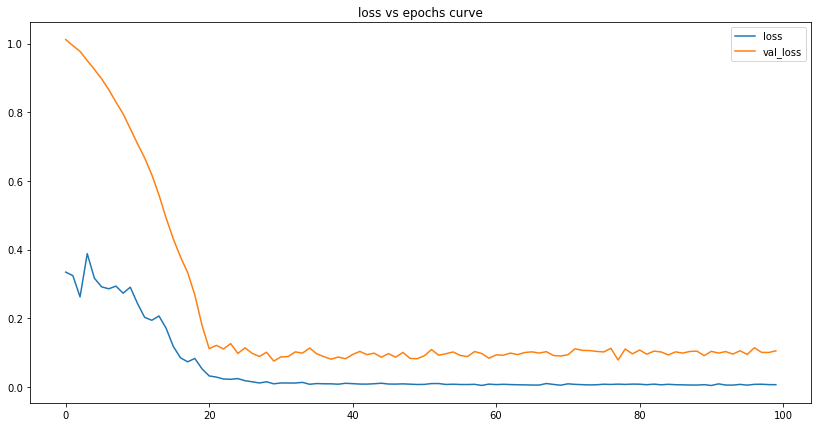
# Long short memory method
us_mape, us_accuracy, us_errs, us_interval, us_std, us_lstm_df = lstm_predict(us_lstm_model)
print_metrics(us_mape, us_accuracy, us_errs, us_interval, us_std, 0)
us_lstm_df
LSTM MAPE: 4.82%
LSTM accuracy: 95.18%
LSTM sum of errors: 2058053740601.0
LSTM prediction interval: 994121.0
LSTM standard deviation: 507204.8083122943
| confirmed | confirmed_predicted | daily | daily_predicted | confirm_min | confirm_max | |
|---|---|---|---|---|---|---|
| 2020-10-22 | 8409341.0 | 8205034.0 | 155448.0 | -94666.0 | 7210912.0 | 9199155.0 |
| 2020-10-23 | 8493088.0 | 8242974.0 | 83747.0 | 37941.0 | 7248853.0 | 9237096.0 |
| 2020-10-24 | 8576818.0 | 8276551.0 | 83730.0 | 33577.0 | 7282430.0 | 9270672.0 |
| 2020-10-25 | 8637625.0 | 8306049.0 | 60807.0 | 29498.0 | 7311928.0 | 9300171.0 |
| 2020-10-26 | 8704423.0 | 8331693.0 | 66798.0 | 25644.0 | 7337572.0 | 9325815.0 |
| 2020-10-27 | 8778055.0 | 8354006.0 | 73632.0 | 22313.0 | 7359885.0 | 9348127.0 |
| 2020-10-28 | 8856413.0 | 8373629.0 | 78358.0 | 19623.0 | 7379508.0 | 9367750.0 |
| 2020-10-29 | 8944934.0 | 8392144.0 | 88521.0 | 18515.0 | 7398022.0 | 9386265.0 |
| 2020-10-30 | 9044255.0 | 8408804.0 | 99321.0 | 16660.0 | 7414683.0 | 9402925.0 |
| 2020-10-31 | 9125482.0 | 8423733.0 | 81227.0 | 14929.0 | 7429611.0 | 9417854.0 |
| 2020-11-01 | NaN | 8435789.0 | NaN | 12056.0 | 7441668.0 | 9429910.0 |
| 2020-11-02 | NaN | 8456020.0 | NaN | 20231.0 | 7461899.0 | 9450142.0 |
| 2020-11-03 | NaN | 8474728.0 | NaN | 18708.0 | 7480607.0 | 9468849.0 |
| 2020-11-04 | NaN | 8492286.0 | NaN | 17558.0 | 7498164.0 | 9486407.0 |
| 2020-11-05 | NaN | 8509005.0 | NaN | 16720.0 | 7514884.0 | 9503127.0 |
| 2020-11-06 | NaN | 8525149.0 | NaN | 16143.0 | 7531027.0 | 9519270.0 |
| 2020-11-07 | NaN | 8540892.0 | NaN | 15744.0 | 7546771.0 | 9535014.0 |
| 2020-11-08 | NaN | 8556397.0 | NaN | 15504.0 | 7562275.0 | 9550518.0 |
| 2020-11-09 | NaN | 8571668.0 | NaN | 15272.0 | 7577547.0 | 9565790.0 |
| 2020-11-10 | NaN | 8586776.0 | NaN | 15108.0 | 7592655.0 | 9580897.0 |
plot_results(us_lstm_df, "USA", "LSTM")
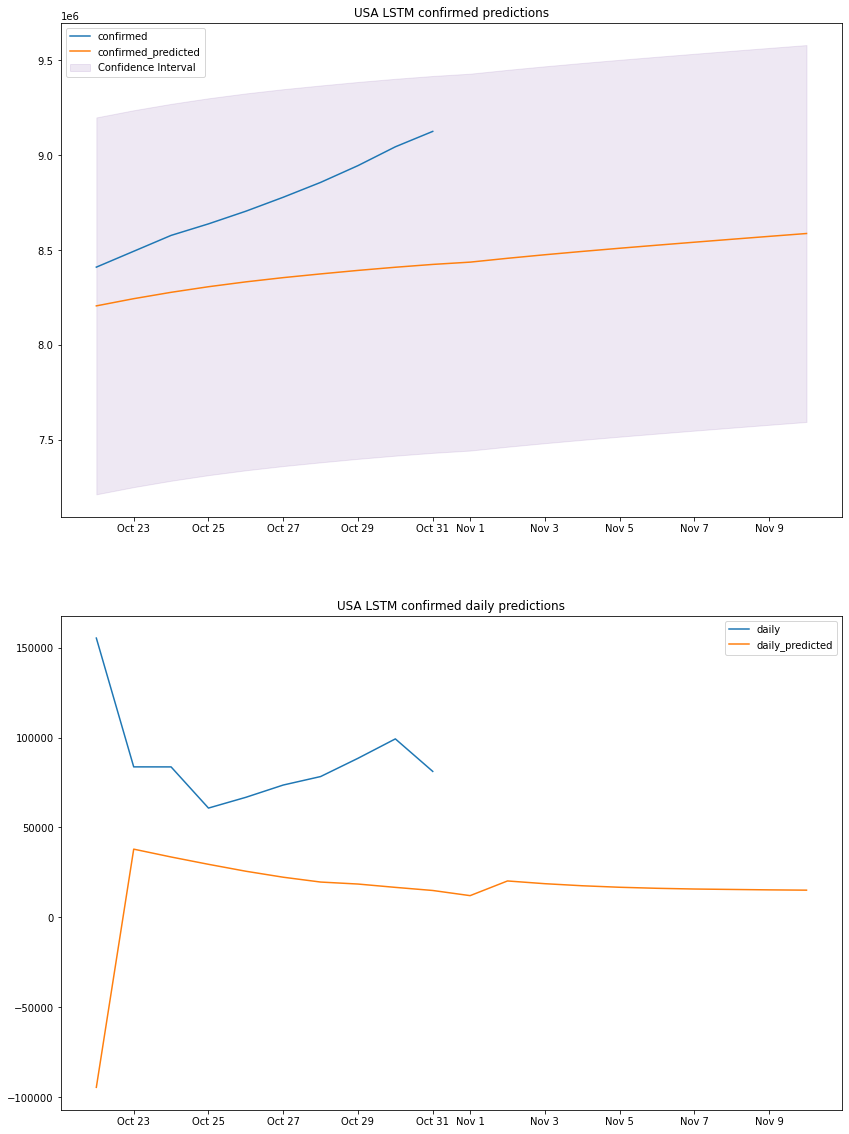
# Auto Regressive Integrated Moving Average
us_mape, us_accuracy, us_errs, us_interval, us_std, us_arima_df = arima_predict(8, 1, 1)
print_metrics(us_mape, us_accuracy, us_errs, us_interval, us_std, 1)
us_arima_df
ARIMA MAPE: 0.72%
ARIMA accuracy: 99.28%
ARIMA sum of errors: 58884624871.0
ARIMA prediction interval: 168156.0
ARIMA standard deviation: 85793.81160044324
| confirmed | confirmed_predicted | daily | daily_predicted | confirm_min | confirm_max | |
|---|---|---|---|---|---|---|
| 2020-10-22 | 8409341.0 | 8406811.0 | 155448.0 | 138884.0 | 8238655.0 | 8574967.0 |
| 2020-10-23 | 8493088.0 | 8476524.0 | 83747.0 | 69713.0 | 8308368.0 | 8644680.0 |
| 2020-10-24 | 8576818.0 | 8536828.0 | 83730.0 | 60303.0 | 8368672.0 | 8704983.0 |
| 2020-10-25 | 8637625.0 | 8593830.0 | 60807.0 | 57002.0 | 8425674.0 | 8761986.0 |
| 2020-10-26 | 8704423.0 | 8654269.0 | 66798.0 | 60439.0 | 8486113.0 | 8822425.0 |
| 2020-10-27 | 8778055.0 | 8716789.0 | 73632.0 | 62520.0 | 8548633.0 | 8884945.0 |
| 2020-10-28 | 8856413.0 | 8782879.0 | 78358.0 | 66089.0 | 8614723.0 | 8951034.0 |
| 2020-10-29 | 8944934.0 | 8853301.0 | 88521.0 | 70422.0 | 8685145.0 | 9021457.0 |
| 2020-10-30 | 9044255.0 | 8921778.0 | 99321.0 | 68477.0 | 8753622.0 | 9089933.0 |
| 2020-10-31 | 9125482.0 | 8984015.0 | 81227.0 | 62237.0 | 8815859.0 | 9152170.0 |
| 2020-11-01 | NaN | 9043905.0 | NaN | 59891.0 | 8875750.0 | 9212061.0 |
| 2020-11-02 | NaN | 9104850.0 | NaN | 60944.0 | 8936694.0 | 9273006.0 |
| 2020-11-03 | NaN | 9167791.0 | NaN | 62941.0 | 8999635.0 | 9335947.0 |
| 2020-11-04 | NaN | 9234322.0 | NaN | 66531.0 | 9066166.0 | 9402478.0 |
| 2020-11-05 | NaN | 9303277.0 | NaN | 68955.0 | 9135121.0 | 9471433.0 |
| 2020-11-06 | NaN | 9369836.0 | NaN | 66560.0 | 9201681.0 | 9537992.0 |
| 2020-11-07 | NaN | 9431964.0 | NaN | 62128.0 | 9263808.0 | 9600120.0 |
| 2020-11-08 | NaN | 9491890.0 | NaN | 59926.0 | 9323734.0 | 9660046.0 |
| 2020-11-09 | NaN | 9551959.0 | NaN | 60069.0 | 9383803.0 | 9720114.0 |
| 2020-11-10 | NaN | 9613919.0 | NaN | 61961.0 | 9445763.0 | 9782075.0 |
plot_results(us_arima_df, "USA", "incremental ARIMA")
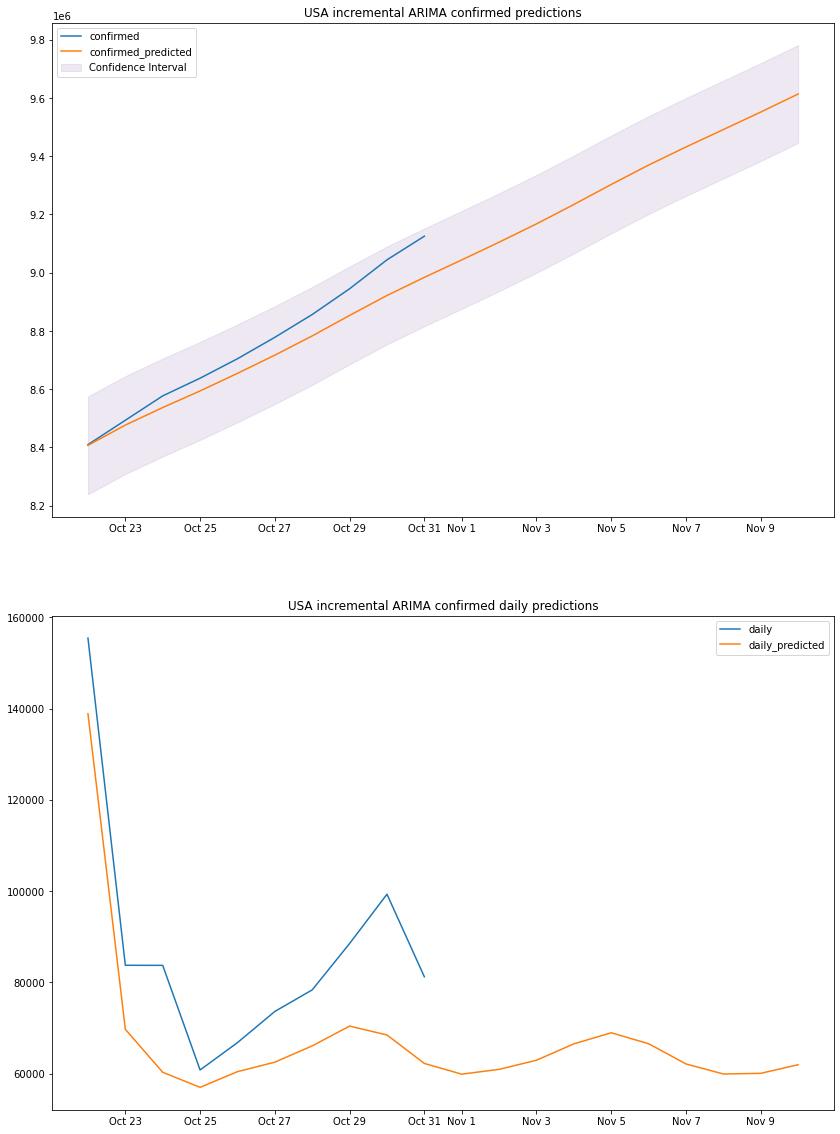
# Holts Exponential Smoothing
us_mape, us_accuracy, us_errs, us_interval, us_std, us_hes_df = hes_predict()
print_metrics(us_mape, us_accuracy, us_errs, us_interval, us_std, 2)
us_hes_df
HES MAPE: 0.83%
HES accuracy: 99.17%
HES sum of errors: 75839516016.0
HES prediction interval: 190835.0
HES standard deviation: 97364.98088117794
| confirmed | confirmed_predicted | daily | daily_predicted | confirm_min | confirm_max | |
|---|---|---|---|---|---|---|
| 2020-10-22 | 8409341.0 | 8400415.0 | 155448.0 | 125551.0 | 8209580.0 | 8591251.0 |
| 2020-10-23 | 8493088.0 | 8463191.0 | 83747.0 | 62776.0 | 8272356.0 | 8654027.0 |
| 2020-10-24 | 8576818.0 | 8525967.0 | 83730.0 | 62776.0 | 8335132.0 | 8716802.0 |
| 2020-10-25 | 8637625.0 | 8588743.0 | 60807.0 | 62776.0 | 8397907.0 | 8779578.0 |
| 2020-10-26 | 8704423.0 | 8651518.0 | 66798.0 | 62776.0 | 8460683.0 | 8842354.0 |
| 2020-10-27 | 8778055.0 | 8714294.0 | 73632.0 | 62776.0 | 8523459.0 | 8905129.0 |
| 2020-10-28 | 8856413.0 | 8777070.0 | 78358.0 | 62776.0 | 8586234.0 | 8967905.0 |
| 2020-10-29 | 8944934.0 | 8839845.0 | 88521.0 | 62776.0 | 8649010.0 | 9030681.0 |
| 2020-10-30 | 9044255.0 | 8902621.0 | 99321.0 | 62776.0 | 8711786.0 | 9093457.0 |
| 2020-10-31 | 9125482.0 | 8965397.0 | 81227.0 | 62776.0 | 8774562.0 | 9156232.0 |
| 2020-11-01 | NaN | 9028173.0 | NaN | 62776.0 | 8837337.0 | 9219008.0 |
| 2020-11-02 | NaN | 9090948.0 | NaN | 62776.0 | 8900113.0 | 9281784.0 |
| 2020-11-03 | NaN | 9153724.0 | NaN | 62776.0 | 8962889.0 | 9344559.0 |
| 2020-11-04 | NaN | 9216500.0 | NaN | 62776.0 | 9025664.0 | 9407335.0 |
| 2020-11-05 | NaN | 9279275.0 | NaN | 62776.0 | 9088440.0 | 9470111.0 |
| 2020-11-06 | NaN | 9342051.0 | NaN | 62776.0 | 9151216.0 | 9532887.0 |
| 2020-11-07 | NaN | 9404827.0 | NaN | 62776.0 | 9213992.0 | 9595662.0 |
| 2020-11-08 | NaN | 9467603.0 | NaN | 62776.0 | 9276767.0 | 9658438.0 |
| 2020-11-09 | NaN | 9530378.0 | NaN | 62776.0 | 9339543.0 | 9721214.0 |
| 2020-11-10 | NaN | 9593154.0 | NaN | 62776.0 | 9402319.0 | 9783989.0 |
plot_results(us_hes_df, "USA", "incremental HES")
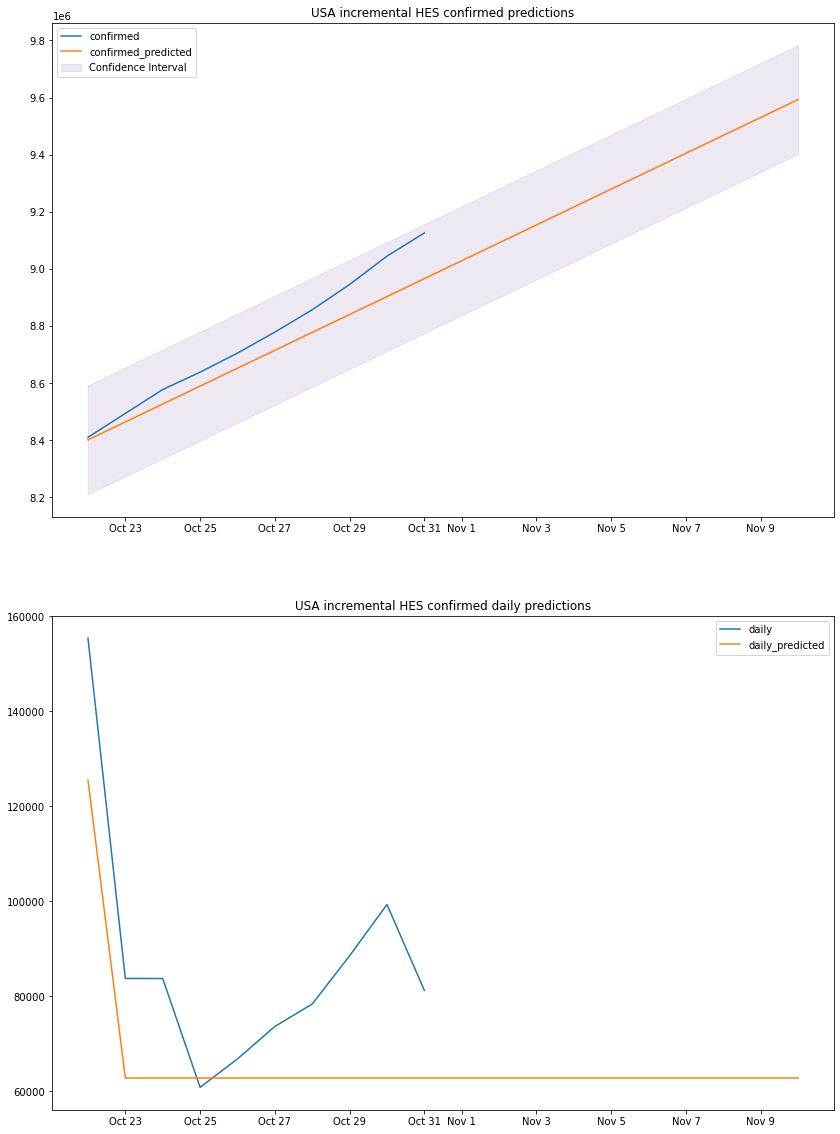
was the US lockdown effective in reducing the cases?
the US started their lockdwon in 2020-03-17 and it was ended by the erupting
protests. tracking the lockdown might be tricky in the US at least because each
state started their lockdown at their own pace and there was no federally
mandated lockdown while some other states never went into lockdowns, taking that
into account we will consider the end of the lockdown to be the end of may which
was the start of the Gorge Floyed protests.
Time frame from 2020-03-17 until 2020-05-31
us_lockdown = get_range_df('2020-03-17', '2020-05-31', us_con_series)
fig, ax = plt.subplots(1, figsize = (14,7))
ax.plot(us_lockdown.index, us_lockdown['confirmed'], label = 'confirmed')
ax.plot(us_lockdown.index, us_lockdown.rolling(7).mean(), label = 'confirmed mean')
ax.legend()
<matplotlib.legend.Legend at 0x7f53d0630f90>
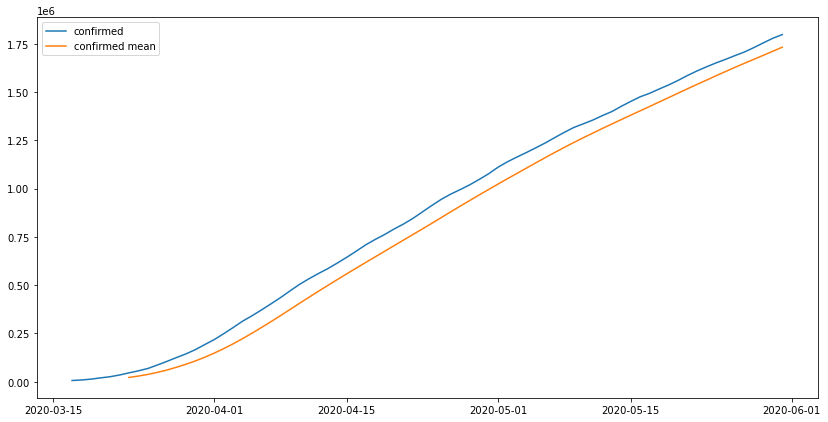
the actual values are above the moving average of each 7 days meaning the lockdown did not work as inteded and the number of cases was still very high when compared to the average of each 7 days, to make sure our previous model predictions are accurate we will use this period of time as a base and train the model on it and do prediction for the days after that which we already have the data on. we will use the ARIMA model becuase the amount of data we have will not train a neural network ideally.
scaler, train, test, scaled_train, scaled_test, generator, validation_gen = prepare_data(us_lockdown)
# Auto Regressive Integrated Moving Average
us_mape, us_accuracy, us_errs, us_interval, us_std, us_arima_df = arima_predict(8, 1, 1)
print_metrics(us_mape, us_accuracy, us_errs, us_interval, us_std, 1)
us_arima_df = pad_range_df(us_arima_df, us_con_series)
us_arima_df
ARIMA MAPE: 0.55%
ARIMA accuracy: 99.45%
ARIMA sum of errors: 1187672403.0
ARIMA prediction interval: 23881.0
ARIMA standard deviation: 12184.377305753513
| confirmed | confirmed_predicted | daily | daily_predicted | confirm_min | confirm_max | |
|---|---|---|---|---|---|---|
| 2020-05-22 | 1608604.0 | 1610272.0 | 44636.0 | 47633.0 | 1586391.0 | 1634154.0 |
| 2020-05-23 | 1629802.0 | 1632799.0 | 21198.0 | 22527.0 | 1608918.0 | 1656681.0 |
| 2020-05-24 | 1649916.0 | 1653311.0 | 20114.0 | 20511.0 | 1629429.0 | 1677192.0 |
| 2020-05-25 | 1668235.0 | 1674419.0 | 18319.0 | 21108.0 | 1650537.0 | 1698300.0 |
| 2020-05-26 | 1687761.0 | 1695924.0 | 19526.0 | 21505.0 | 1672042.0 | 1719805.0 |
| 2020-05-27 | 1706351.0 | 1719538.0 | 18590.0 | 23614.0 | 1695657.0 | 1743419.0 |
| 2020-05-28 | 1729299.0 | 1744487.0 | 22948.0 | 24949.0 | 1720606.0 | 1768369.0 |
| 2020-05-29 | 1753651.0 | 1768770.0 | 24352.0 | 24283.0 | 1744889.0 | 1792652.0 |
| 2020-05-30 | 1777495.0 | 1791120.0 | 23844.0 | 22350.0 | 1767239.0 | 1815002.0 |
| 2020-05-31 | 1796670.0 | 1812184.0 | 19175.0 | 21064.0 | 1788303.0 | 1836066.0 |
| 2020-06-01 | 1814034.0 | 1833132.0 | 17364.0 | 20948.0 | 1809251.0 | 1857014.0 |
| 2020-06-02 | 1835408.0 | 1854887.0 | 21374.0 | 21755.0 | 1831006.0 | 1878768.0 |
| 2020-06-03 | 1855386.0 | 1878310.0 | 19978.0 | 23423.0 | 1854428.0 | 1902191.0 |
| 2020-06-04 | 1877125.0 | 1902606.0 | 21739.0 | 24296.0 | 1878724.0 | 1926487.0 |
| 2020-06-05 | 1902294.0 | 1926287.0 | 25169.0 | 23682.0 | 1902406.0 | 1950169.0 |
| 2020-06-06 | 1924132.0 | 1948548.0 | 21838.0 | 22261.0 | 1924667.0 | 1972430.0 |
| 2020-06-07 | 1941920.0 | 1969746.0 | 17788.0 | 21198.0 | 1945864.0 | 1993627.0 |
| 2020-06-08 | 1959448.0 | 1990779.0 | 17528.0 | 21033.0 | 1966898.0 | 2014661.0 |
| 2020-06-09 | 1977820.0 | 2012666.0 | 18372.0 | 21887.0 | 1988784.0 | 2036547.0 |
| 2020-06-10 | 1998646.0 | 2035860.0 | 20826.0 | 23194.0 | 2011979.0 | 2059742.0 |
plot_results(us_arima_df, "USA", "incremental ARIMA")
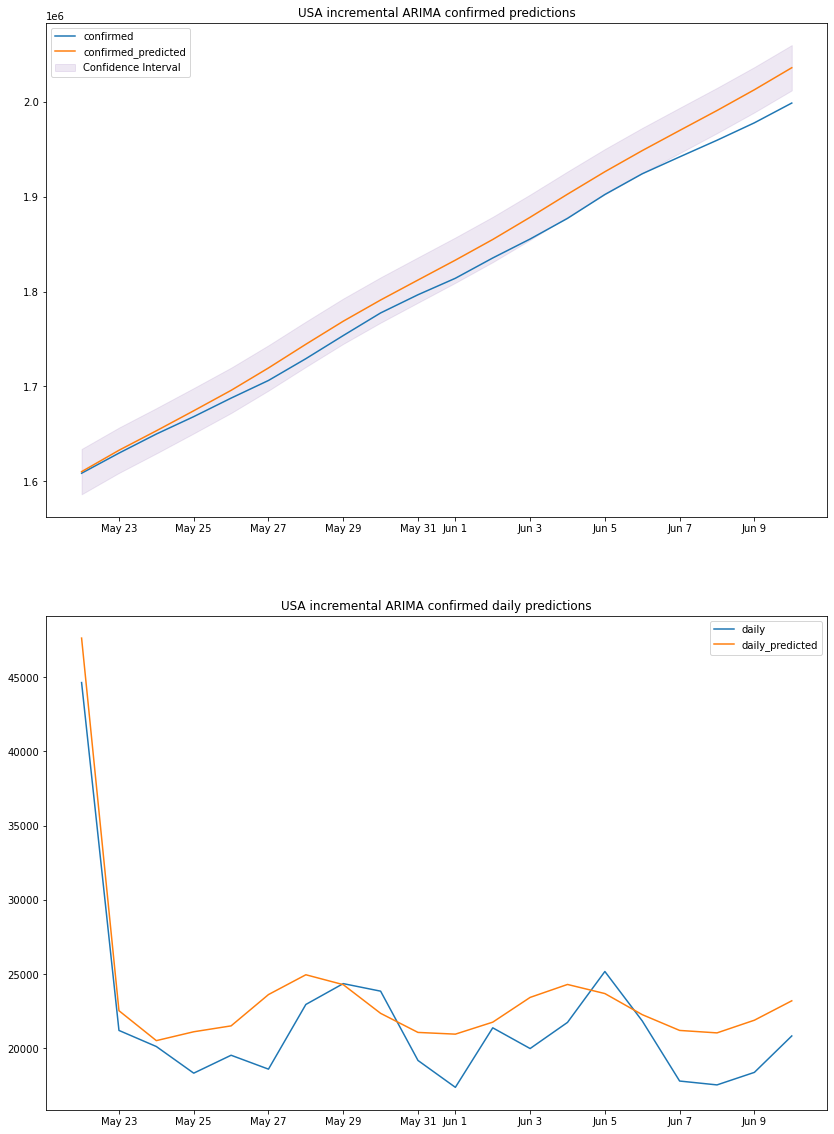
we can see that the predicted totals and predicted daily cases are fairly accurate thus our previous predictions can be taken with some degree of accuracy, and might be used for making decisions.
from all the graphs, functions and numbers above we can come to a simple conclusion that is, there is no single model that will perform best in all scenario even when the data is very similar (in trend not numbers), each model was best for a specific country and wasn’t so far behind in the others for example the HES model is the most accurate with the South Korean dataset but is almost the same as the ARIMA model in Italy.
whats the difference between ARIMA and HES?
ARIMA uses a non-linear function for coefficient calculations, that’s why the
graph does curve sometimes (Italy) while HES is a pure linear method that uses a
linear function and is always a straight line
Considering LSTM is usually the least accurate, is it worth the training
time?
here may be, however, deep learning has its place among machine learning
algorithms and can perform tasks these other functions could never, also the
LSTM model always predicts a wider interval compared to the other 2, in a
practical scenario where range is important the other 2 models will not be ideal
because their results are limited by the original value and don’t spread as
much, the LSTM model could provide better estimates.
ARIMA or HES?
HES, because it takes much less time to train and is as accurate or even more
accurate sometimes.

A deep dive into the intricacies of deploying custom models to Amazon SageMaker

How to create a new novel datasets from a few set of images.

Data Science Project

Data Science Project